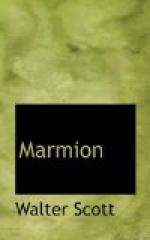line 1084. See above, V. vii, &c.
Stanza XXXVI. line 1096. ’This storm of Lichfield Cathedral, which had been garrisoned on the part of the King, took place in the Great Civil War. Lord Brook, who, with Sir John Gill, commanded the assailants, was shot with a musket-ball through the vizor of his helmet. The royalists remarked that he was killed by a shot fired from St. Chad’s Cathedral, and upon St. Chad’s day, and received his death-wound in the very eye with which, he had said, he hoped to see the ruin of all the cathedrals in England. The magnificent church in question suffered cruelly upon this, and other occasions; the principal spire being ruined by the fire of the besiegers.’—Scott.
Ceadda, or Chad, after resigning the bishopric of York in 669 A. D., was appointed Bp. of Lichfield, where he ’lived for a little while in great holiness.’ See Hunt’s ‘English Church in the Middle Ages,’ p. 17.
line 1110. The allusion is to the old fragment on Flodden, which has been so skilfully extended by Jean Elliot and also by Mrs. Cockburn in their national lyrics, ‘The Flowers o’ the Forest.’
line 1117. Once more the poet uses the irony of events with significant force.
Stanza XXXVII. line 1125. There is now a font of stone with a drinking cup, and an inscription on the back of the font runs thus:- -
’Drink, weary
pilgrim, drink and stay,
Rest by the well
of Sybil Grey.’
Stanza xxxviii. In this stanza the poet indicates the spirit in which romances are written, clearly indicating that those only that have ears will be able to hear. ‘Phonanta sunetoisin’ might be the watchword of all imaginative writers. Cp. Thackeray’s ’Rebecca and Rowena.’
line 1155. Hall and Holinshed were chroniclers of the sixteenth century, to both of whom Shakespeare was indebted for pliant material.
line 1168. Sir Thomas More, Lord Sands, and Anthony Denny. See Henry VIII.
lines 1169-70. The references are to old homely customs at weddings. See Brand’s ‘Popular Antiquities.’




